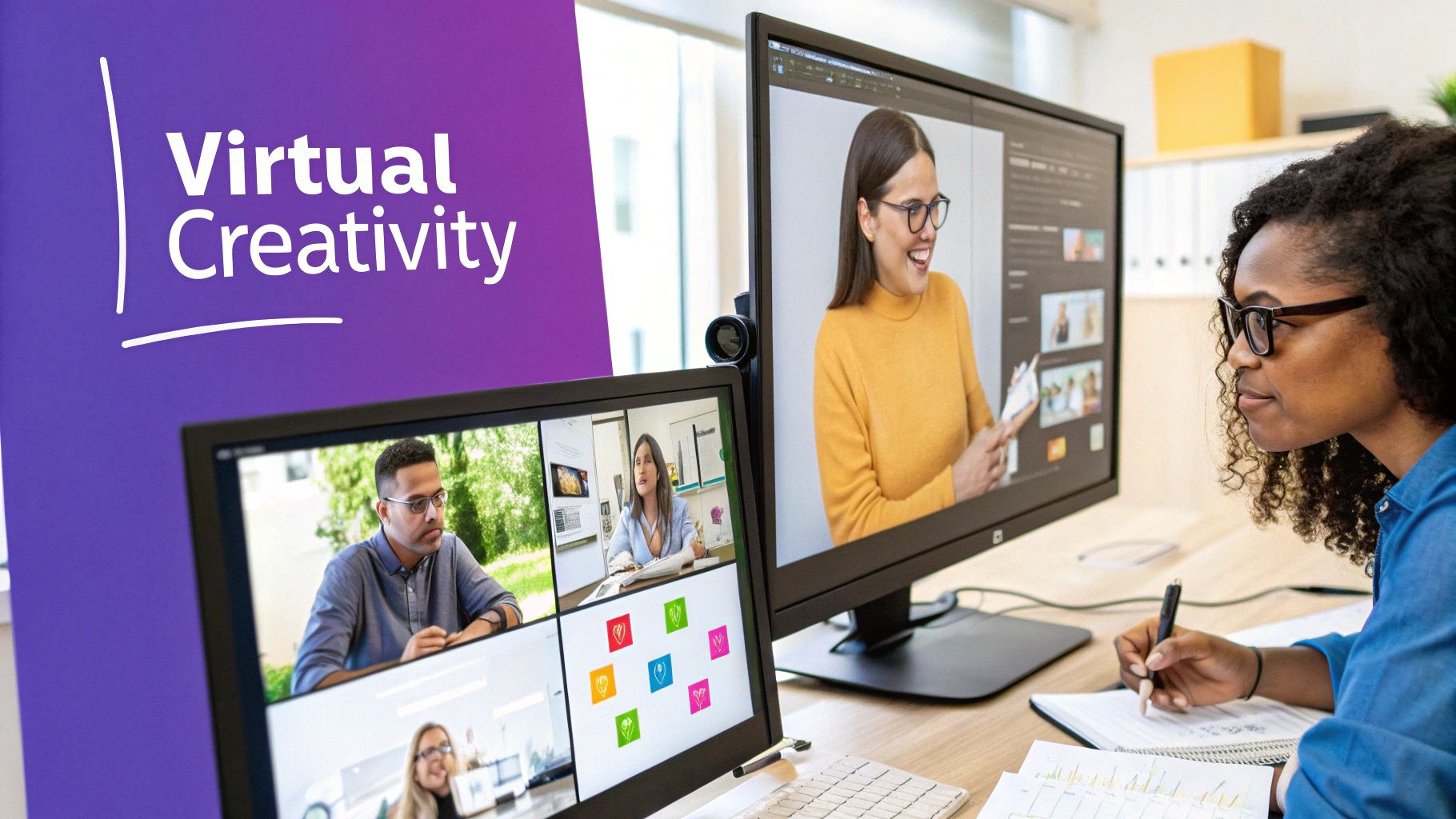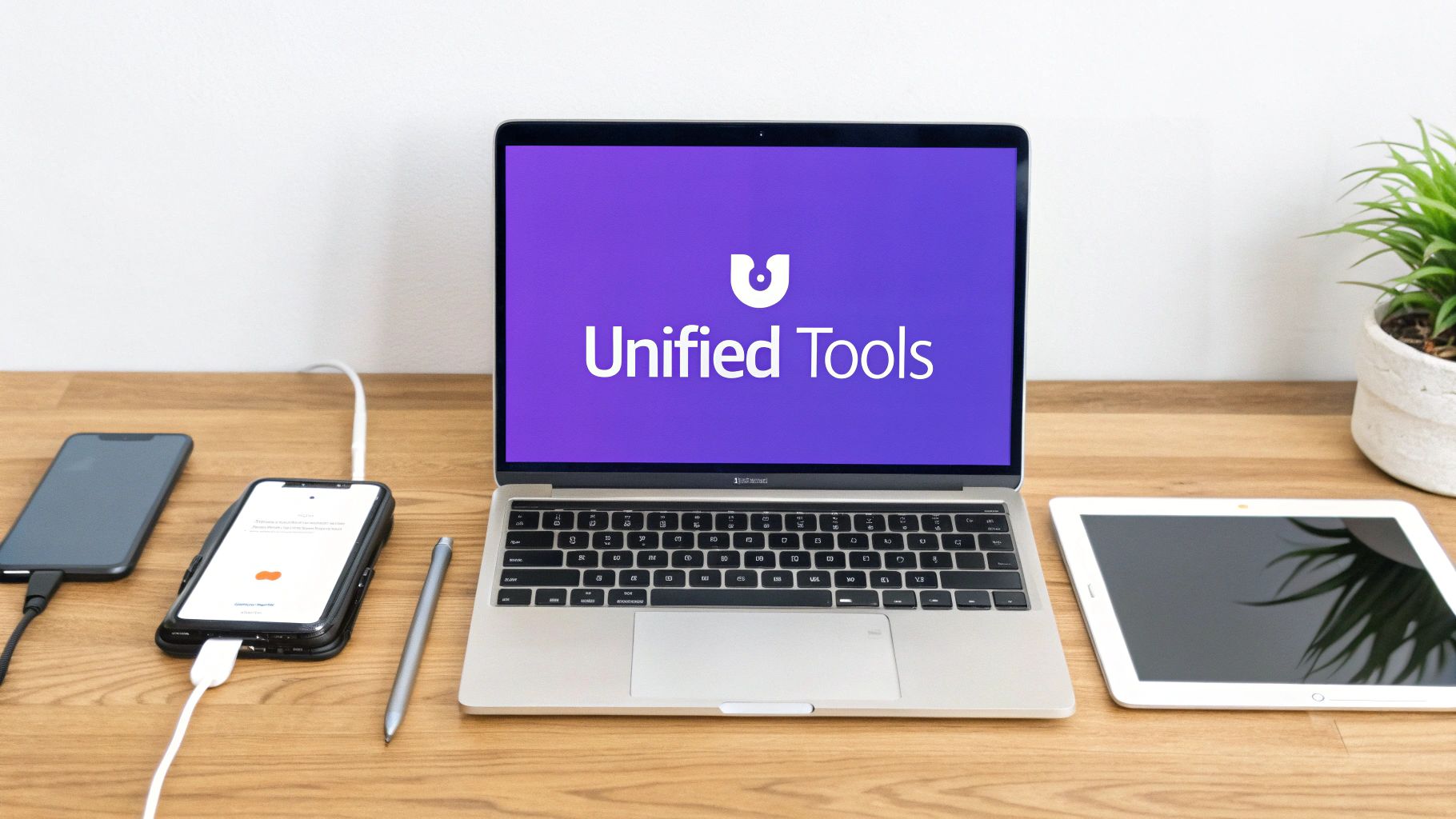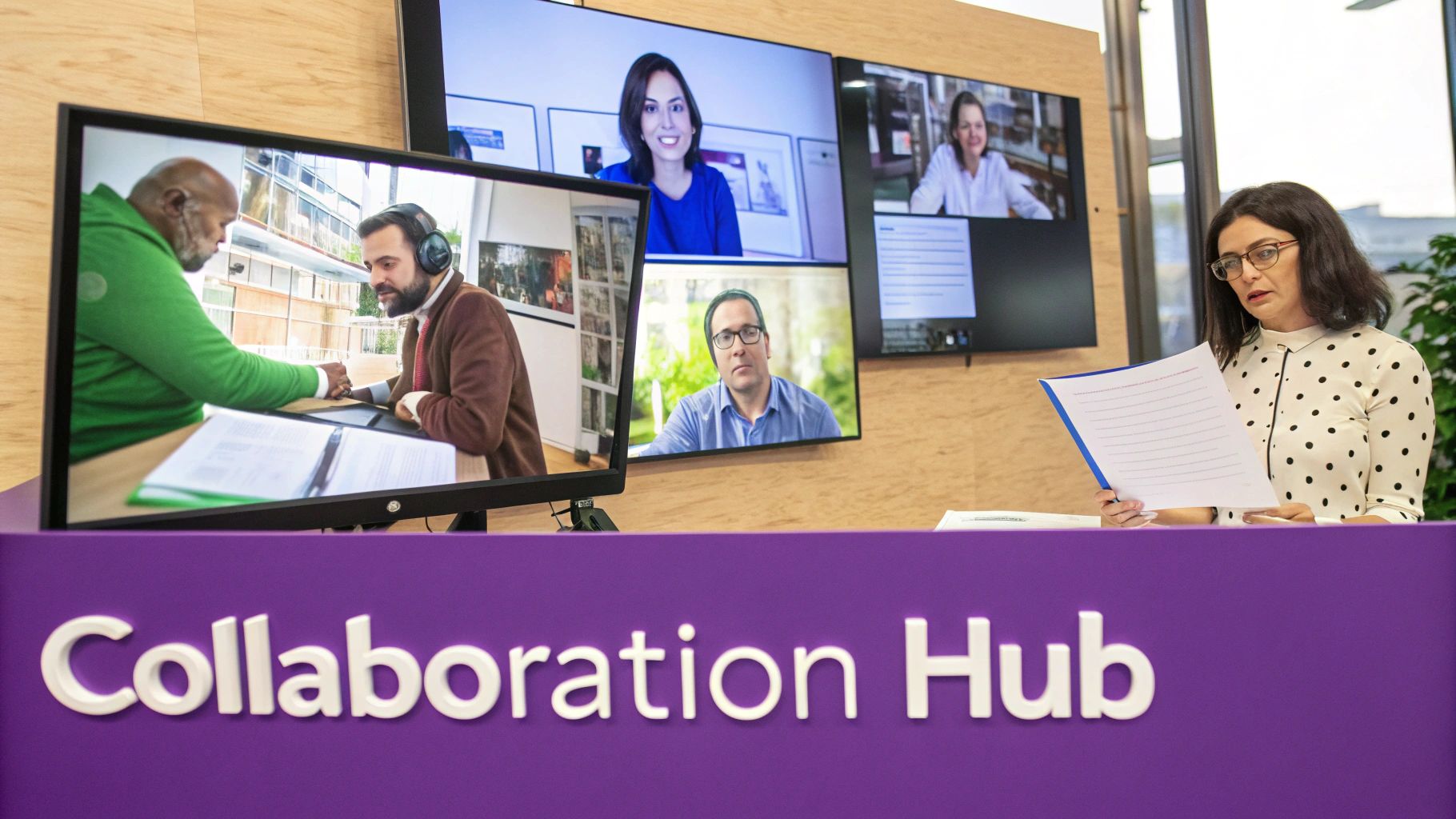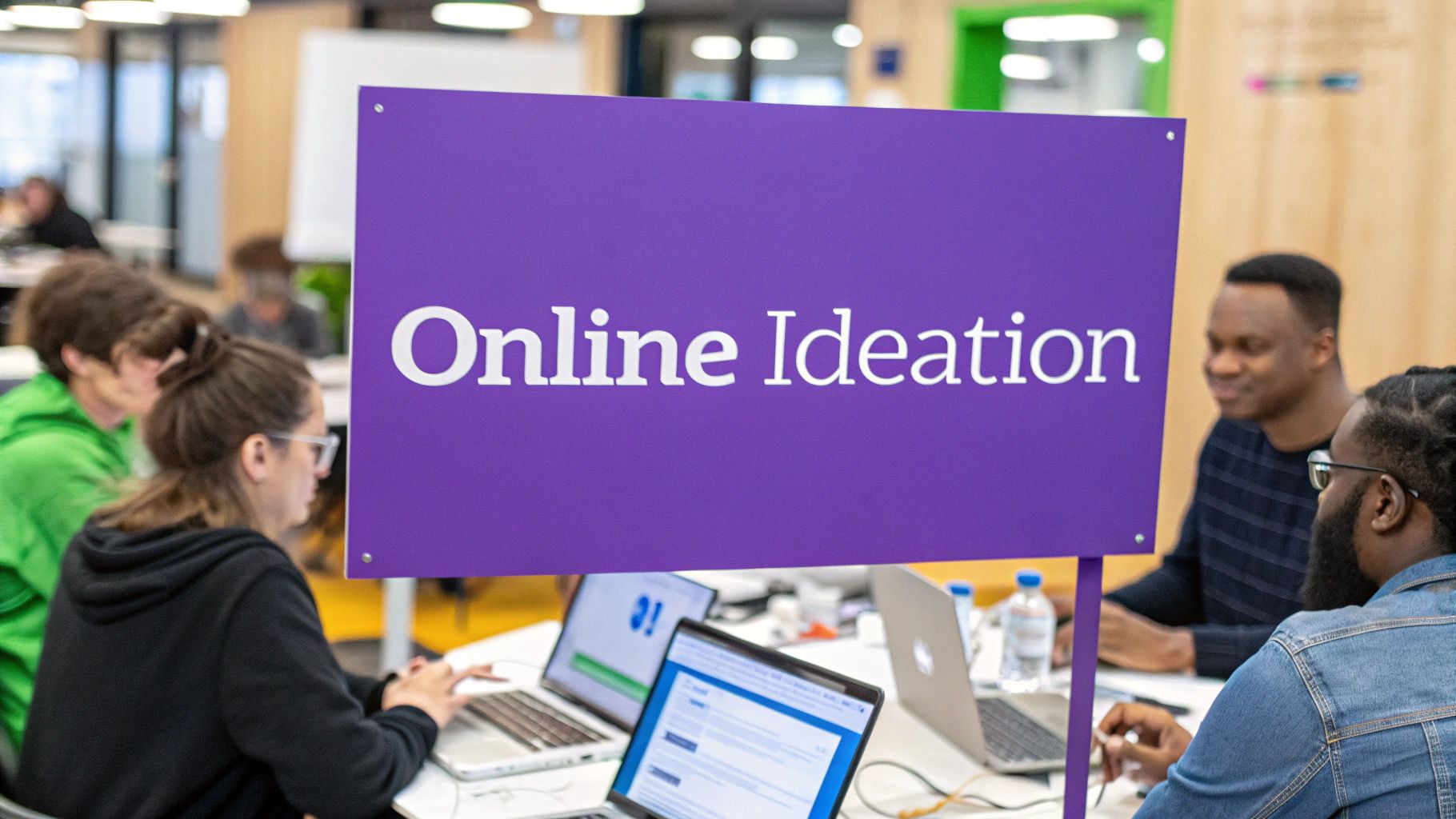Understanding the New Landscape of Virtual Collaboration

Teams have found fresh ways to work together since remote work became common. Many companies now rely on online brainstorming to keep their teams connected and productive. This shift from in-person to virtual collaboration looks like it's here to stay, changing how we share and develop ideas.
Moving brainstorming online comes with its own set of hurdles. The natural flow of face-to-face meetings can be hard to capture in a virtual setting. And while physical whiteboards make it easy to sketch out ideas together, digital tools require some getting used to. Getting everyone involved equally can also be trickier when meeting remotely.
The rise of remote work during COVID-19 sparked major changes in how teams collaborate. By 2020, there was a 176% jump in collaboration app installations on work devices. Around 66% of employees worked from home during this time, with many choosing to stick with remote work even after offices reopened. You can find more details here: Remote Work Statistics. These numbers show that online brainstorming has become essential for modern businesses.
Overcoming the Challenges of Virtual Brainstorming
Many companies have found good solutions to make virtual brainstorming work well. Success often comes from understanding what remote teams need most during these sessions. This includes planning for home office distractions and creating clear activities to keep everyone focused.
Key Strategies for Effective Online Brainstorming
- Structured Facilitation: Having someone lead the session helps keep everyone on track and makes sure all voices are heard
- Visual Collaboration Tools: Digital whiteboards and shared documents give teams a common space to work together
- Asynchronous Brainstorming: Letting people add ideas over time works better for different schedules and encourages deeper thinking
- Clear Objectives and Guidelines: Setting specific goals and rules helps everyone understand what they need to do
When teams use these approaches, they often find that online brainstorming works really well. It helps create good ideas and builds stronger connections between team members, no matter where they work. This leads to better teamwork, clearer communication, and more success with remote work.
Selecting and Mastering Virtual Ideation Tools

Picking the right online tools makes a big difference in how well your team brainstorms together. Different teams need different things based on their work style and goals. Understanding what tools are out there and how they can help improve your online sessions is key to success.
Essential Features of Effective Brainstorming Tools
Good online brainstorming tools share some important features that help teams think better together:
- Real-Time Collaboration: Everyone can edit and share ideas at the same time, keeping the energy flowing
- Visual Tools: Digital whiteboards and mind maps help make abstract ideas concrete and clear
- Smart Organization: Ways to tag, sort and prioritize ideas make it easy to track progress
- Works With Other Tools: Smooth connection to project tools and chat apps keeps ideas moving forward
- Easy to Use: Simple, clear design helps everyone participate, no matter their tech skills
Building Your Virtual Ideation Ecosystem
The best teams use multiple tools together to get better results. A well-planned mix of tools lets you brainstorm in different ways.
For example, you might use Bulby for focused brainstorming sessions, then move those ideas into Asana or Trello to track what gets done. Adding tools like Slack or Microsoft Teams helps keep discussions going between sessions.
Maximizing Engagement and Participation
Getting everyone involved makes online brainstorming work better. Studies show that 79% of marketers find interactive content helps people remember messages better (source). Using polls, quizzes and videos turns passive sessions into fun, engaging experiences.
Overcoming Tool Adoption Challenges
Sometimes teams resist using new tools. Clear communication and training help smooth the way. Show how the tool solves specific problems and improves brainstorming. Ask for feedback and act on it. When people feel heard and supported, they're more likely to embrace new ways of working together.
Integrating Agile Principles for Better Outcomes
Agile methodologies have transformed how teams run online brainstorming sessions. By focusing on quick idea generation, testing and refinement, teams can turn brainstorming into real results. This step-by-step process keeps everyone motivated and moving forward.
Adapting Sprint-Based Approaches to Ideation
The sprint-based approach from software development works great for online brainstorming too. Each session becomes a focused mini-sprint with clear goals. You might dedicate one sprint to finding solutions for a specific customer issue. Setting firm timeframes and desired outcomes prevents endless discussions that go nowhere.
Maintaining Creative Momentum and Actionable Ideas
The focus on actionable outcomes is key. Rather than just listing many ideas, teams quickly evaluate and prioritize them. Testing concepts right away shows what will work and what won't. This keeps creativity flowing while turning abstract ideas into concrete plans.
Continuous feedback is another vital element. Regular check-ins help teams improve their brainstorming process over time. They can adjust session formats, try new techniques, and refine how they evaluate ideas. Learn more about Agile's impact on online brainstorming here. Since its rise in the 1990s, Agile has helped teams generate better ideas faster and make clearer decisions.
Frameworks for Quick Idea Evaluation and Decision-Making
Agile offers simple frameworks for evaluating ideas during brainstorming. The MoSCoW method helps teams sort ideas into:
- Must have: Core features needed for success
- Should have: Important but not essential items
- Could have: Nice additions if time allows
- Won't have: Features explicitly left out for now
This helps teams focus on high-impact ideas first. The Impact/Effort Matrix is another useful tool that plots ideas based on their potential results versus work required. Teams can then prioritize quick wins with big impact.
Keeping Remote Teams Aligned and Engaged
Agile practices help keep virtual teams connected and productive during brainstorming. Using tools like Bulby's collaborative whiteboards, teams can see ideas take shape, track progress, and stay aligned. The structured exercises and AI guidance ensure everyone contributes meaningfully. Visual elements and interactive features maintain focus in virtual settings. Regular feedback creates transparency and shared commitment to the team's goals.
New Technologies for Better Brainstorming

The way teams brainstorm online is getting better thanks to exciting new tools and technologies. These tools help make remote brainstorming sessions more fun, productive and full of fresh ideas. Let's look at some key technologies that are making online idea generation better than ever.
Virtual Reality for Better Team Collaboration
Virtual Reality (VR) creates amazing new ways for teams to work together online. Teams can meet in shared virtual spaces no matter where they are physically located. In these spaces, they can:
- See and interact with 3D product models
- Move and adjust virtual objects together
- Work side-by-side just like in real life
- Record sessions for later review
VR brings several key benefits like anonymous participation, avatars for representation, full immersion, multiple ways to communicate, and the ability to work with simulated objects. Read more about VR's creative potential here.
AI Tools That Help Teams Think Better
Artificial intelligence is becoming a valuable brainstorming partner. AI tools can:
- Guide teams through structured exercises
- Make sure everyone participates equally
- Spot patterns and connections in ideas
- Analyze data to suggest new possibilities
- Help remote teams stay focused and engaged
These AI capabilities help teams come up with more ideas faster and find innovative solutions they might have missed otherwise.
Making the Most of New Tools with Bulby
Bulby works seamlessly with emerging technologies like VR and AI to make brainstorming even better. By combining Bulby's proven exercises with immersive VR experiences and smart AI analysis, teams can generate and develop ideas in powerful new ways.
Getting Ready for What's Next
As these technologies keep improving, they'll become standard tools for online brainstorming. To make the most of them, teams should:
- Test new tools and approaches
- Get comfortable with the technology
- Learn what works best for their needs
- Create a culture that welcomes new ideas
- Provide good training and support
The teams that embrace these tools while staying focused on effective collaboration will be best positioned to create breakthrough ideas in the future.
Mastering Virtual Facilitation Techniques
Leading online brainstorming requires confident facilitation skills. Good facilitators can turn an online meeting from messy to focused and productive. They know how to maintain energy, include everyone, and foster an environment where people feel safe contributing ideas.
Creating Psychological Safety in Digital Spaces
Psychological safety gives brainstorming sessions wings. When people know they can share without judgment, unique ideas flow more freely. Set clear expectations upfront about respectful communication and welcoming all viewpoints. Simple ground rules about active listening and constructive feedback help too.
Start with quick icebreakers to help people connect. Ask each person to share something light like a fun fact or their favorite way to unwind. These small moments of personal connection help create a relaxed space where creativity can flourish.
Reading Virtual Room Dynamics and Handling Challenges
Online meetings have their own rhythms and signals. Watch for facial expressions and body language in video feeds. Notice who's participating in chat and collaborative tools like Bulby. An alert facilitator picks up on these cues and adjusts their approach.
But virtual sessions come with specific hurdles. Tech glitches, home distractions, and varying comfort with online tools can limit participation. Prepare by sharing platform instructions beforehand and having tech support ready. When issues pop up, stay calm and have backup plans ready.
Guiding Groups Toward Meaningful Outcomes: Techniques and Strategies
Good facilitation moves beyond logistics to guide groups toward real results. Here are key techniques that help:
- Structured Exercises: Use methods like "Six Thinking Hats" or "SCAMPER" to spark different ways of thinking
- Timeboxing: Set clear time limits to keep energy high and prevent dragging
- Visual Aids: Share virtual whiteboards and mind maps through Bulby to make ideas visible and buildable
- Regular Breaks: Schedule short pauses to prevent screen fatigue, especially in longer sessions
Encouraging Participation and Managing Dominant Personalities
Balance is key – make space for quieter voices while gently redirecting those who might dominate. One effective approach is "round robin" sharing, where each person gets a set time to contribute. This structure helps online groups, as some find it easier to speak up when there's a clear system.
When you master these virtual facilitation skills, your online brainstorming becomes more productive and engaging. Tools like Bulby can help by offering guided exercises and AI support to bring out your team's best ideas.
Measuring and Maximizing Virtual Brainstorming Impact

Getting real results from online brainstorming takes more than just gathering people in a virtual meeting. You need clear ways to measure success and keep improving over time. Let's look at practical ways to evaluate and enhance your team's brainstorming sessions.
Key Performance Indicators for Online Brainstorming
The right metrics help show if your brainstorming is working. While having good attendance matters, focus on these concrete results:
- Number of Ideas: More ideas often lead to better solutions. Keep track across different sessions to see which methods help your team generate the most ideas.
- Quality Rating: Not every idea will be a winner. Create a simple scoring system based on how practical, original and impactful each idea is. This helps you identify the best ones to work on.
- Implementation Success: Track how many ideas actually become reality and what results they achieve. This shows the real value of your brainstorming efforts.
- Time to Action: Note how long it takes to go from initial ideas to a clear action plan. Look for ways to make this process faster while maintaining quality.
Gathering Meaningful Participant Feedback
Understanding how participants feel about the sessions helps make them better:
- Quick Surveys: Send short questionnaires right after each session to learn what worked well and what needs improvement.
- Private Feedback: Give people a way to share thoughts anonymously, especially about sensitive topics or suggestions for better facilitation.
- Individual Check-ins: Have brief one-on-one chats to get detailed feedback people may not want to share in a group setting.
Strategies for Continuous Improvement
Online brainstorming gets better with practice and refinement:
- Try Different Methods: Test out various techniques like mind mapping or reverse brainstorming. See which ones work best for your specific team.
- Improve Leadership: Good facilitation makes brainstorming more productive. Work on managing time better, ensuring everyone participates, and creating a supportive environment.
- Use Helpful Tools: The right software makes a big difference. Tools like Bulby provide structured exercises and built-in collaboration features to help organize your sessions.
By measuring results, listening to feedback, and fine-tuning your approach, you can make online brainstorming a reliable source of great ideas. This creates an ongoing cycle of improvement that helps your team reach its creative potential.
Ready to make your virtual brainstorming more effective? See how Bulby's AI-powered platform and proven exercises can help your team generate better ideas and get real results. Start your free trial today!

